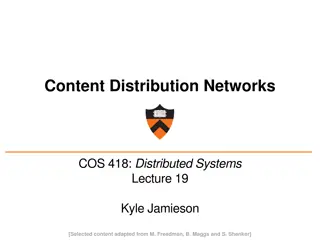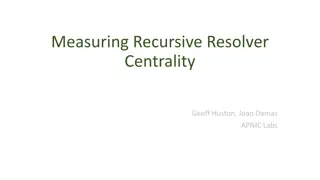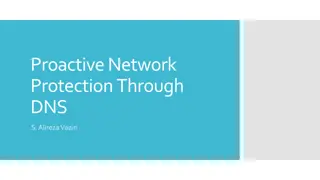Understanding Domain Names for Authoritative DNS Servers
Researchers need to accurately define the types of authoritative DNS servers they sample when measuring server properties. This study focuses on collecting domain names used for web servers to assess typical domain name characteristics, highlighting the importance of accurate data for research purposes. The process involves culling millions of unique domain names to create a dataset for analysis, testing, and obtaining results relating to IPv4 addresses, DNSSEC signatures, TLS startup times, and more design considerations for typical DNS servers. This research aims to enhance understanding and improve the assessment of authoritative name servers on the Internet.
Download Presentation

Please find below an Image/Link to download the presentation.
The content on the website is provided AS IS for your information and personal use only. It may not be sold, licensed, or shared on other websites without obtaining consent from the author. Download presentation by click this link. If you encounter any issues during the download, it is possible that the publisher has removed the file from their server.
E N D
Presentation Transcript
Not So Popular: A Sample of Domain Names for Typical Web Sites Paul Hoffman DNS-OARC 34 February 2021
Motivation When researchers measure the properties of the authoritative DNS servers on the Internet, they first need to define the types of authoritative servers they are sampling Collecting domain names used for web servers is fairly easy, and is thus the basis of much research on authoritative name servers The current collections of domain names against which one can do research are not that good for assessing things about typical domain names Most popular web sites Extracts from the zone files of gTLDs Dumps from passive DNS collection systems 2
External links on Wikipedia pages Wikipedia has wikis in almost every language External links go to a large variety of real but not popular web pages governments of small cities colleges and universities of all sizes obscure sports teams small regional music and movie studios personal sites of academics Worldwide coverage 3
Collection and analysis Retrieve the database of external links for each language Wikipedia from a mirror of the main Wikipedia site Extract all the external links Clean up the list of external links, limit to http: and https: For each remaining URL, strip off the scheme and everything after the domain name Cull the list of domain names so that only one copy of each domain name remains 4
The dataset 750 databases were from 2020-01-01 After culling, 7.35 million unique domain names in the dataset Use a random sample of 100,000 from that dataset for testing Needed to start with more than 100,000 because many names could not be resolved to an IPv4 address 5
Test results 17% also had IPv6 addresses 4% of those IPv4 addresses were signed with DNSSEC Also timed startup of TLS to help work in DPRIVE Short document from ICANN in OCTO document series, hopefully within a few months More design detail, TCP/TLS numbers, more considerations for what is typical , ... 6
Questions ...and comments 7























